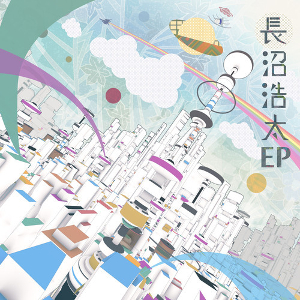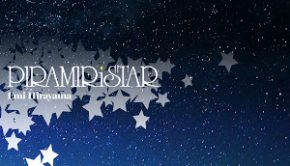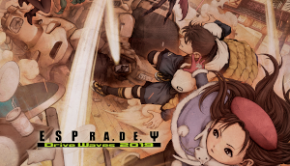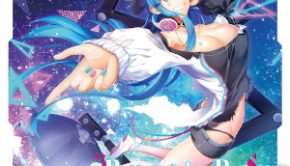Kohta Naganuma EP – Yes! We Are Kohta Naganuma!
 |
Album Title: Kohta Naganuma EP – Yes! We Are Kohta Naganuma! |
| Record Label: Naganuma |
|
| Catalog No.: NGNM-0001 |
|
| Release Date: April 29, 2013 |
|
| Purchase: Buy Used Copy |
Overview
Takahiro Eguchi has a cult following after his start with Supersweep and his foray into the doujin scene under several different nicknames. As an attempt to release something a little different, He made up a fake name of “Kohta Naganuma” (in which he also uses the nickname Sakana-ya as an alternative to this style). Under this name, he has released one solo album, titled Kohta Naganuma EP – Yes! We Are Kohta Naganuma! giving us a wide range of styles and arranges normally not heard from him. To confuse matters, his co-star of the album is also named “Kohta Naganuma.” (Which I will refer to his nickname of s-Don to avoid said confusion) So, after the success of pgh1, how does “Yes We Are” stand up?
Body
The album opens with the extended version of “SHI☆O★KA☆RA” from pgh1. The track begins with a wonderful orchestral interlude leading into the same intro as the other version. The expansion on the original synth melody and Japanese flute sections is taken to the next level with the addition of some slower synth passages and a funky guitar solo. Continuing on with Eguchi’s “star” tracks, “SHI★N☆MI★SO” is a more quirky and playful tune. Keeping the electronic style, this track has a somewhat slower beat. The song is highlighted by a chiptune solo section and driving xylophone melodies. “MO★TSU★NA★BE” is quite strange compared with the rest. It begins with a dial up modem sound effect, and a stronger dance beat. The melody is quite out of place led by a shamisen and square wave synth. It is quite a strange combination of instruments but is nonetheless one of the catchiest beats on the album.
s-Don’s contributions are closer to the standard electronic fare we would hear from most other composers. “MI☆SO☆KA☆TSU☆ (evianized mix)” is heavily piano driven, with a deep industrial undertone. “Shiokara ~Back to the Future~” is probably my favorite s-Don piece here. It has a very heavy club dance beat, with a progressive melody that very subtly blends in certain melody points from Eguchi’s versions of Shiokara. The arranged melody portions are extremely distorted, offering very little discernable from the original. However, everything comes together in a very creative way. This one is rough to explain, you’ll just have to give it a try! S-Don’s contributions come to a close on track 11 (I do not have a reliable translation for the track title). This one also follows a heavy club dance beat. Distorted vocals and a very catchy bassline cover the majority of the track. The highlight however, comes in around 2:34, where the style makes a complete 180 and showcases a very rich and sexy dubstep wobble. I could listen to that section for hours!
The next several tracks here don’t follow any of the standard styles so far discussed. “Flying Fish,” arguably one of my favorite Eguchi tracks ever, goes back to the style from Paragraph. A very soft and ephemeral synth fades in using a melody played backwards. Every few seconds, another soft layer is added on to build the intensity. Around 1:46, a beautiful saxophone melody is layered in. Everything then drops back out and the formula is repeated, however the next time the saxophone comes in the harmonizing synth is much more intense. “The Sea of Memory” by kanone also changes things up by introducing dubstep elements into the formula. The track follows a more organic progression unlike a lot of other dubstep tracks. Using the same flowing synths that have been commonplace throughout the album, kanone drives the reduced dance beat with electric guitar and piano until about halfway though. At the climax he brings on quite a nice synth “drop,” which afterwards layers of the track begin to fall off until its close. These two tracks mentioned here are clearly the most different, but also show some of the most enjoyable instrumentation and should NOT be passed up!
Eguchi personally closes the album with two upbeat electronic pieces similar to the opening track. “Ragnarok Anniversary” is probably the one that is the most “standard” when it comes to what you would expect from Eguchi. It is a fast paced synth driven piece, however dropping into some really exquisite instrumental sections. A guitar solo precedes a beautiful piano silence dropout, which is then layered with the opening synth. This is followed by a key change and a riveting guitar and synth passage. The track ends with the melody reduced to only chiptune. The final track, “Yes! We Are Kohta Naganuma,” consolidates the two composer’s styles into one very elegant and driving electronic piece. The track blends a jazz ambiance with the faster electronic style of Takahiro Eguchi. I would say this track is here just to show off a multitude of synth solos. It really is the pinnacle of the album and showcases everything it has to offer.
We can’t leave without talking about the other two artists that joined Eguchi and s-Don on the album. Ayatsugu Otowa brings us two very different styles. One with “WABISABI+RomanceDawn” showing off a very playful side. This tune just bleeds happiness, using a “breathy” synth to lead the track and a bagpipe like synth to back it up. This track is just fun. There really isn’t any other way to describe it. “TA☆KO☆WA☆SA,” however, is completely on the other side of the spectrum. The same synth vocals chanting the spelling of the titles (just like the other star tracks) covers much of this very heavy dance track. The synth remains playful, but is led with an electric guitar and an almost rave like beat. ETIA. brings us our final track on the album, which is a hardcore arrangement of “SHI☆O★KA☆RA.” Not much was really changed from the original here. The tempo has been ramped up and the beat is much more powerful. To me, “SHI☆O★KA☆RA” doesn’t play as well as a hardcore track. That doesn’t mean that this track isn’t good, but the charm and variety that made the original so special has been stripped out of this version.
Summary
This was a much more fun ride that I expected when I first got my hands on this album. While Eguchi’s other solo albums held true to his beautiful and charming style, this one left a lot more room for him (and the others) to branch out. What that leaves us with is some of the composer’s most varied and unique works out there. His plan to partner up with s-Don was an excellent idea. I cant find one track on here from either artist that isn’t enjoyable. I may be biased as a RAVING fan of Takahiro Eguchi, but I have to say that this is also a must have for anyone who enjoys his more heartfelt works. This one may even be more accessible with the varied artists and many more styles to choose from. If you are a fan of anything else Eguchi has done in the past, this album will be a no brainer. If you like the organic styles that come from anything on the KLAMNOP label this is also one to add to your list. It is rare, and it is unique, but it is one of my most treasured albums to this day.
Do you agree with the review and score? Let us know in the comments below!
4.5
Posted on April 9, 2014 by Bryan Matheny. Last modified on April 9, 2014.














